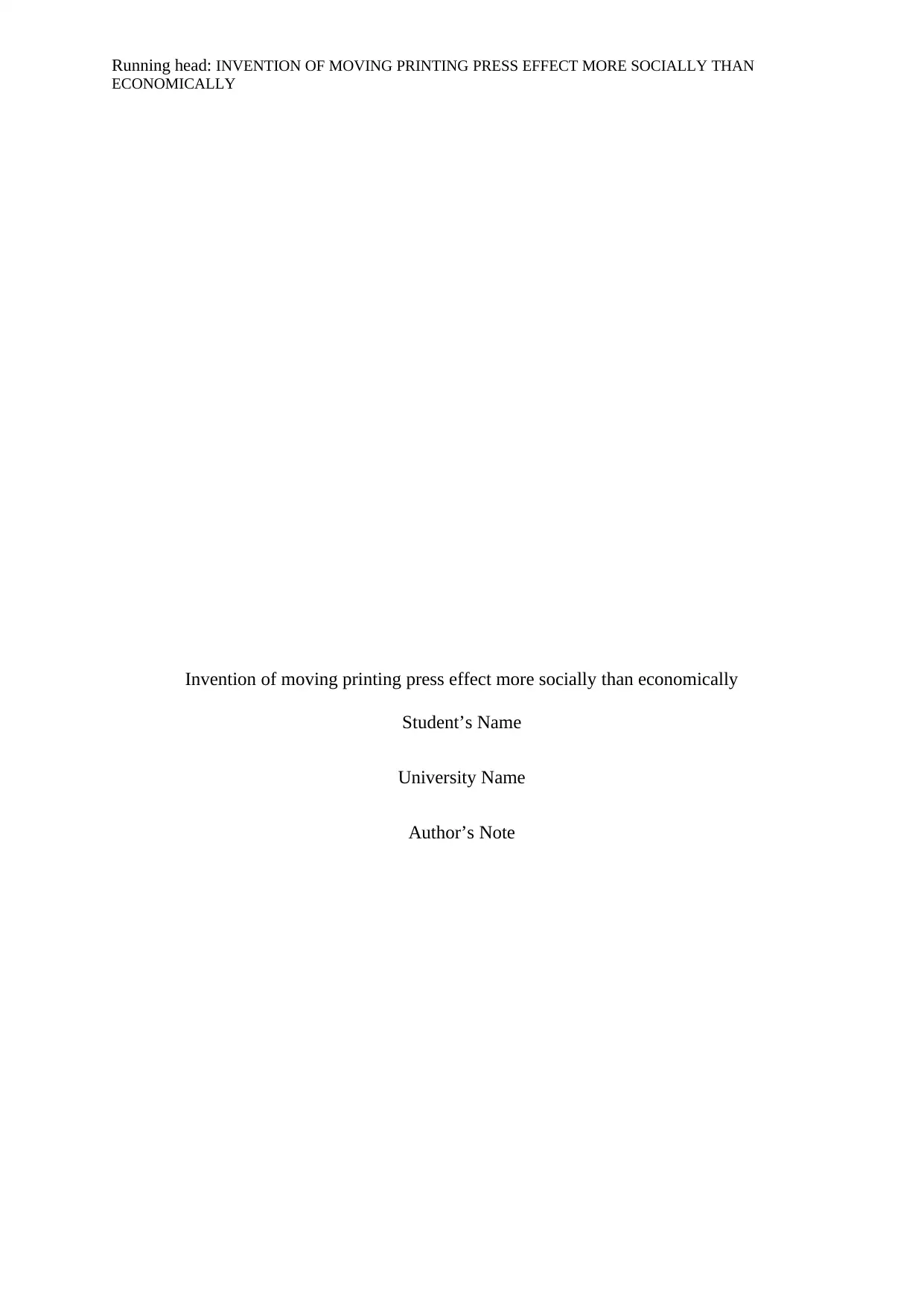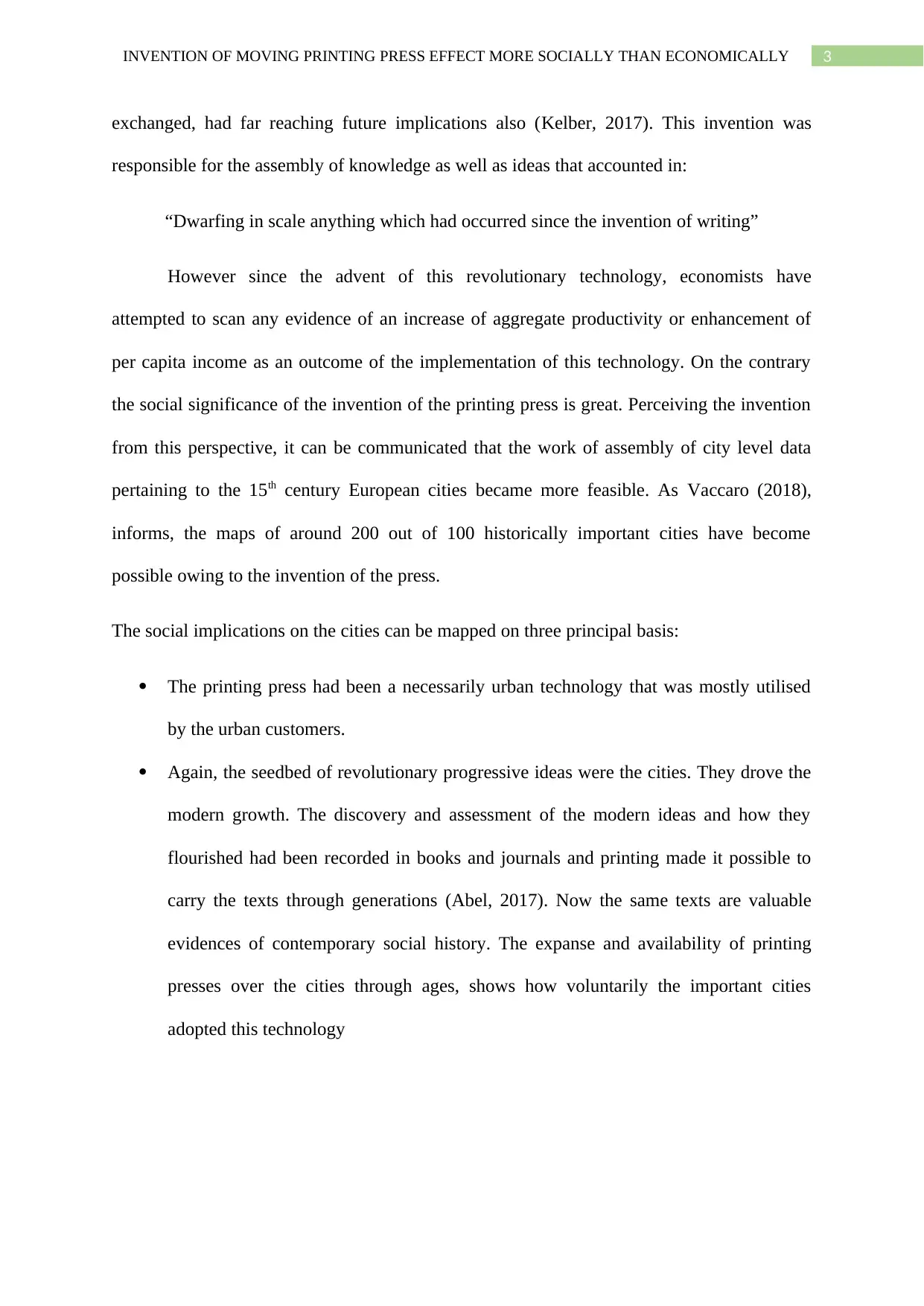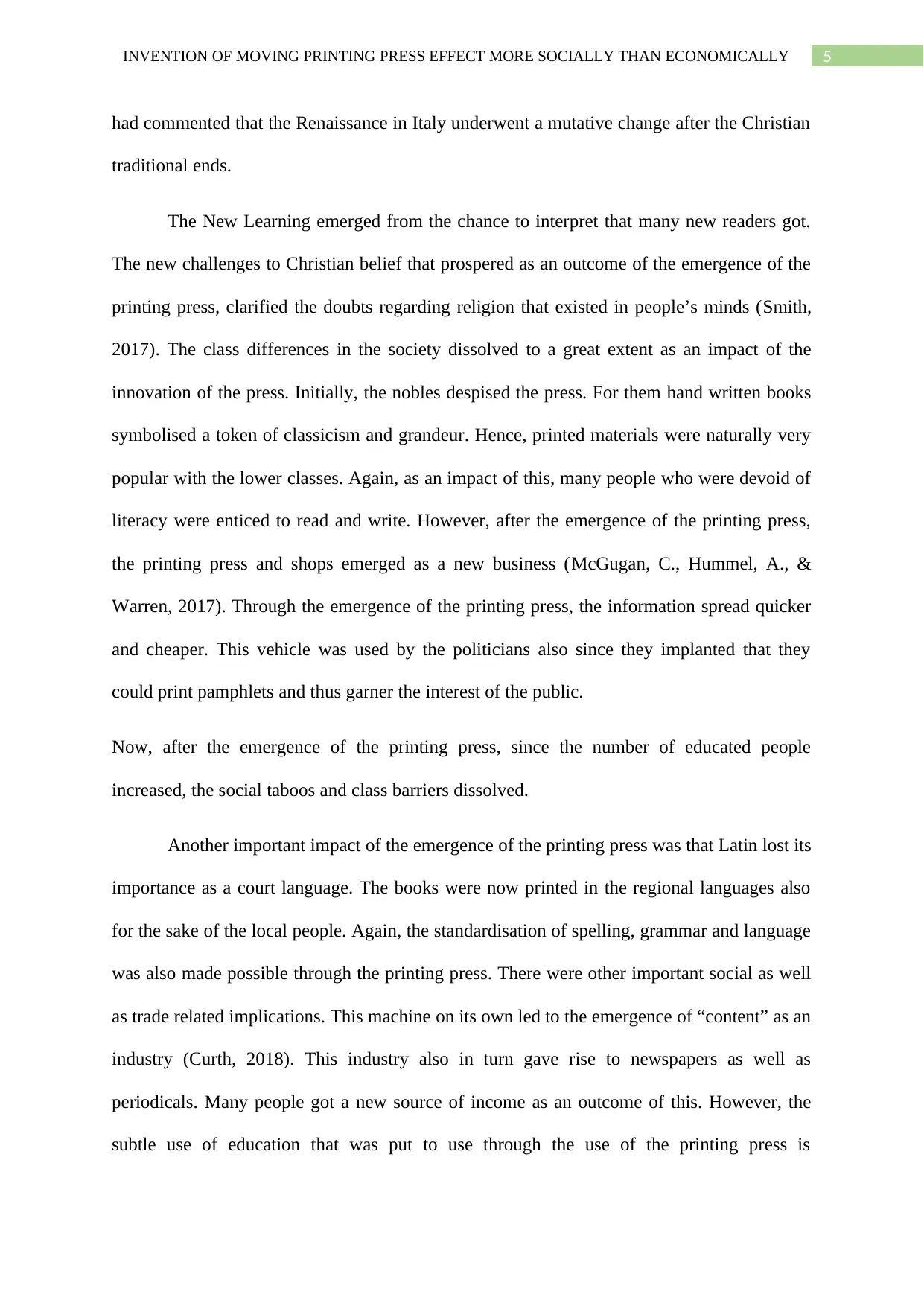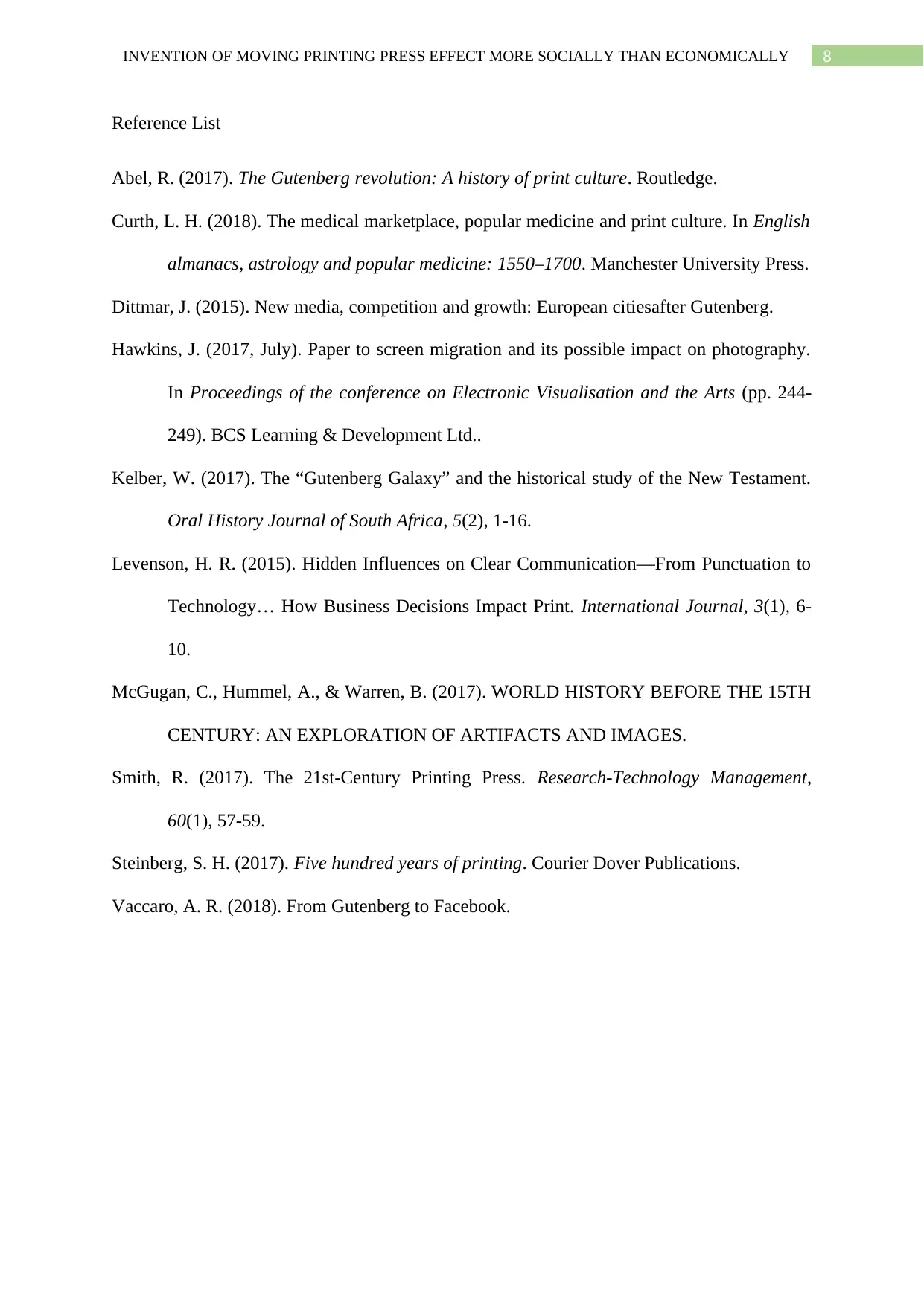Invention of Printing Press: Social Impact over Economic Effect
VerifiedAdded on 2023/05/29
|8
|1874
|58
Essay
AI Summary
This essay argues that the invention of the printing press had a more significant social impact than economic one. While Gutenberg intended to make money, the printing press revolutionized literacy, making books more accessible and empowering lower classes. The essay discusses how the printing press shifted content interpretation, diminishing the Church's sole authority. It highlights the urban nature of the technology, its role in spreading progressive ideas, and its contribution to dissolving class differences and standardizing languages. The rise of 'content' as an industry, including newspapers and magazines, is also examined, concluding that the printing press unintentionally became a vehicle for mass media and social change.

Running head: INVENTION OF MOVING PRINTING PRESS EFFECT MORE SOCIALLY THAN
ECONOMICALLY
Invention of moving printing press effect more socially than economically
Student’s Name
University Name
Author’s Note
ECONOMICALLY
Invention of moving printing press effect more socially than economically
Student’s Name
University Name
Author’s Note
Paraphrase This Document
Need a fresh take? Get an instant paraphrase of this document with our AI Paraphraser

2INVENTION OF MOVING PRINTING PRESS EFFECT MORE SOCIALLY THAN ECONOMICALLY
Introduction
There is no disagreeing the fact that the business benefits or the trade scope of the
invention of the printing press was less. However, the major impact that this innovative
technology had was over the perception of literacy. After the invention of the press, the
people of the lower classes were also able to perceive the value of education and reading and
buying books became a whole lot cheaper affair after the emergence of the movable orienting
press.
Gutenberg had adverted a device just to make money. However, in no time, the social
implications of the printing press had far outgone the economic values that it came with.
Another important topic of discussion is that the printing press did not only impact the spread
of content, but also changed the style of interpretation of content. Previously, the religious
heads of the churches were in solo charges of reading out to the people what were written in
the religious texts. However, now, when the texts were being printed in local languages also,
the people were able to read those, by themselves. In this essay, how the world of literacy
changed and how it impacted social changes and the spread of commerce have been
reflected in detail. However, the most important aspect is that the technological facility that
was adverted for the purpose of making money only, became a major vehicle of social
change.
Discussion
The movable printing press had been a great revolution of information technology that
took place in the Renaissance period. The history of the invention of printing press provides
closest parallel to the emergence of the internet. There were far reaching economic
importance of the ways this revolutionary technology reduced the cost of dissemination of
ideas. However, using the printing press, the ways in which knowledge was stored and later
Introduction
There is no disagreeing the fact that the business benefits or the trade scope of the
invention of the printing press was less. However, the major impact that this innovative
technology had was over the perception of literacy. After the invention of the press, the
people of the lower classes were also able to perceive the value of education and reading and
buying books became a whole lot cheaper affair after the emergence of the movable orienting
press.
Gutenberg had adverted a device just to make money. However, in no time, the social
implications of the printing press had far outgone the economic values that it came with.
Another important topic of discussion is that the printing press did not only impact the spread
of content, but also changed the style of interpretation of content. Previously, the religious
heads of the churches were in solo charges of reading out to the people what were written in
the religious texts. However, now, when the texts were being printed in local languages also,
the people were able to read those, by themselves. In this essay, how the world of literacy
changed and how it impacted social changes and the spread of commerce have been
reflected in detail. However, the most important aspect is that the technological facility that
was adverted for the purpose of making money only, became a major vehicle of social
change.
Discussion
The movable printing press had been a great revolution of information technology that
took place in the Renaissance period. The history of the invention of printing press provides
closest parallel to the emergence of the internet. There were far reaching economic
importance of the ways this revolutionary technology reduced the cost of dissemination of
ideas. However, using the printing press, the ways in which knowledge was stored and later

3INVENTION OF MOVING PRINTING PRESS EFFECT MORE SOCIALLY THAN ECONOMICALLY
exchanged, had far reaching future implications also (Kelber, 2017). This invention was
responsible for the assembly of knowledge as well as ideas that accounted in:
“Dwarfing in scale anything which had occurred since the invention of writing”
However since the advent of this revolutionary technology, economists have
attempted to scan any evidence of an increase of aggregate productivity or enhancement of
per capita income as an outcome of the implementation of this technology. On the contrary
the social significance of the invention of the printing press is great. Perceiving the invention
from this perspective, it can be communicated that the work of assembly of city level data
pertaining to the 15th century European cities became more feasible. As Vaccaro (2018),
informs, the maps of around 200 out of 100 historically important cities have become
possible owing to the invention of the press.
The social implications on the cities can be mapped on three principal basis:
The printing press had been a necessarily urban technology that was mostly utilised
by the urban customers.
Again, the seedbed of revolutionary progressive ideas were the cities. They drove the
modern growth. The discovery and assessment of the modern ideas and how they
flourished had been recorded in books and journals and printing made it possible to
carry the texts through generations (Abel, 2017). Now the same texts are valuable
evidences of contemporary social history. The expanse and availability of printing
presses over the cities through ages, shows how voluntarily the important cities
adopted this technology
exchanged, had far reaching future implications also (Kelber, 2017). This invention was
responsible for the assembly of knowledge as well as ideas that accounted in:
“Dwarfing in scale anything which had occurred since the invention of writing”
However since the advent of this revolutionary technology, economists have
attempted to scan any evidence of an increase of aggregate productivity or enhancement of
per capita income as an outcome of the implementation of this technology. On the contrary
the social significance of the invention of the printing press is great. Perceiving the invention
from this perspective, it can be communicated that the work of assembly of city level data
pertaining to the 15th century European cities became more feasible. As Vaccaro (2018),
informs, the maps of around 200 out of 100 historically important cities have become
possible owing to the invention of the press.
The social implications on the cities can be mapped on three principal basis:
The printing press had been a necessarily urban technology that was mostly utilised
by the urban customers.
Again, the seedbed of revolutionary progressive ideas were the cities. They drove the
modern growth. The discovery and assessment of the modern ideas and how they
flourished had been recorded in books and journals and printing made it possible to
carry the texts through generations (Abel, 2017). Now the same texts are valuable
evidences of contemporary social history. The expanse and availability of printing
presses over the cities through ages, shows how voluntarily the important cities
adopted this technology
⊘ This is a preview!⊘
Do you want full access?
Subscribe today to unlock all pages.

Trusted by 1+ million students worldwide

4INVENTION OF MOVING PRINTING PRESS EFFECT MORE SOCIALLY THAN ECONOMICALLY
No of Cities with Printing press, as of 1470 (red dots demarcating the cities)
No of Cities with Printing press, as of 1500 (red dots demarcating the cities)
(Source: Hawkins, 2017)
The mobile printing press an innovation that seemed from the outset as a profit making
entrepreneurship. However, the primary innovation in the context of printing-the metal alloy
combination as well as the process that was required casting he metal type remained as a
trade secret for more than a century. Again, entrepreneurs of the printing technology had been
emphatically Germans and the cities surrounding Mainz were first to innovate in this
technology (Steinberg, 2017). Western culture lost its distinctive traits of medievalism and
started to exhibit traits of modernism after the advent of the press. In fact Einstein in 1979
No of Cities with Printing press, as of 1470 (red dots demarcating the cities)
No of Cities with Printing press, as of 1500 (red dots demarcating the cities)
(Source: Hawkins, 2017)
The mobile printing press an innovation that seemed from the outset as a profit making
entrepreneurship. However, the primary innovation in the context of printing-the metal alloy
combination as well as the process that was required casting he metal type remained as a
trade secret for more than a century. Again, entrepreneurs of the printing technology had been
emphatically Germans and the cities surrounding Mainz were first to innovate in this
technology (Steinberg, 2017). Western culture lost its distinctive traits of medievalism and
started to exhibit traits of modernism after the advent of the press. In fact Einstein in 1979
Paraphrase This Document
Need a fresh take? Get an instant paraphrase of this document with our AI Paraphraser

5INVENTION OF MOVING PRINTING PRESS EFFECT MORE SOCIALLY THAN ECONOMICALLY
had commented that the Renaissance in Italy underwent a mutative change after the Christian
traditional ends.
The New Learning emerged from the chance to interpret that many new readers got.
The new challenges to Christian belief that prospered as an outcome of the emergence of the
printing press, clarified the doubts regarding religion that existed in people’s minds (Smith,
2017). The class differences in the society dissolved to a great extent as an impact of the
innovation of the press. Initially, the nobles despised the press. For them hand written books
symbolised a token of classicism and grandeur. Hence, printed materials were naturally very
popular with the lower classes. Again, as an impact of this, many people who were devoid of
literacy were enticed to read and write. However, after the emergence of the printing press,
the printing press and shops emerged as a new business (McGugan, C., Hummel, A., &
Warren, 2017). Through the emergence of the printing press, the information spread quicker
and cheaper. This vehicle was used by the politicians also since they implanted that they
could print pamphlets and thus garner the interest of the public.
Now, after the emergence of the printing press, since the number of educated people
increased, the social taboos and class barriers dissolved.
Another important impact of the emergence of the printing press was that Latin lost its
importance as a court language. The books were now printed in the regional languages also
for the sake of the local people. Again, the standardisation of spelling, grammar and language
was also made possible through the printing press. There were other important social as well
as trade related implications. This machine on its own led to the emergence of “content” as an
industry (Curth, 2018). This industry also in turn gave rise to newspapers as well as
periodicals. Many people got a new source of income as an outcome of this. However, the
subtle use of education that was put to use through the use of the printing press is
had commented that the Renaissance in Italy underwent a mutative change after the Christian
traditional ends.
The New Learning emerged from the chance to interpret that many new readers got.
The new challenges to Christian belief that prospered as an outcome of the emergence of the
printing press, clarified the doubts regarding religion that existed in people’s minds (Smith,
2017). The class differences in the society dissolved to a great extent as an impact of the
innovation of the press. Initially, the nobles despised the press. For them hand written books
symbolised a token of classicism and grandeur. Hence, printed materials were naturally very
popular with the lower classes. Again, as an impact of this, many people who were devoid of
literacy were enticed to read and write. However, after the emergence of the printing press,
the printing press and shops emerged as a new business (McGugan, C., Hummel, A., &
Warren, 2017). Through the emergence of the printing press, the information spread quicker
and cheaper. This vehicle was used by the politicians also since they implanted that they
could print pamphlets and thus garner the interest of the public.
Now, after the emergence of the printing press, since the number of educated people
increased, the social taboos and class barriers dissolved.
Another important impact of the emergence of the printing press was that Latin lost its
importance as a court language. The books were now printed in the regional languages also
for the sake of the local people. Again, the standardisation of spelling, grammar and language
was also made possible through the printing press. There were other important social as well
as trade related implications. This machine on its own led to the emergence of “content” as an
industry (Curth, 2018). This industry also in turn gave rise to newspapers as well as
periodicals. Many people got a new source of income as an outcome of this. However, the
subtle use of education that was put to use through the use of the printing press is

6INVENTION OF MOVING PRINTING PRESS EFFECT MORE SOCIALLY THAN ECONOMICALLY
unprecedented. The subscribers of a common magazine or newsletter were considered as a
social group that shared the similar interests. However, hardly any of the members had
interpersonal communication. Writers were a more respectable and influential lot in the
society. Firstly, there were thousands of copies of a single content published in the market.
More than that, the content was published in several languages and the number of readers
were much more now, that also being a contribution of the emergence of the printing press
(Dittmar, 2015). There are few other economic implications of the advent of the press.
Firstly, the printing press was being made use of by the small business organisations for the
publications of brochures as well as advertising pamphlets. In the sales propaganda, this had
an immense influence and the business volume of many of the traders enhanced as an impact
of this.
The most beneficial impact of the press was to be perceived from its movable and
interchangeable type. The primary technology that was used in the press was latter made use
of in the production of guns in the United States (Levenson, 2015). Mass production in any
sector was first conceptualised through the printing press.
Conclusion
In the initial time, printing press was perceived only as a machine that would benefit
the trading community to make a lot of money. The business prospect that Gutenberg saw in
the press, became the weapon for the spread of renaissance across states and countries. The
spread of mass media that is a stark reality today where there have been thousands of virtual
spaces of communication created, had actually been an innovation of the printing press. The
reading of the same newspaper and magazines bonded all the readers in to a virtual
community. In the end, it can be emphatically stated that Gutenberg made a huge impact on
mass media unintentionally.
unprecedented. The subscribers of a common magazine or newsletter were considered as a
social group that shared the similar interests. However, hardly any of the members had
interpersonal communication. Writers were a more respectable and influential lot in the
society. Firstly, there were thousands of copies of a single content published in the market.
More than that, the content was published in several languages and the number of readers
were much more now, that also being a contribution of the emergence of the printing press
(Dittmar, 2015). There are few other economic implications of the advent of the press.
Firstly, the printing press was being made use of by the small business organisations for the
publications of brochures as well as advertising pamphlets. In the sales propaganda, this had
an immense influence and the business volume of many of the traders enhanced as an impact
of this.
The most beneficial impact of the press was to be perceived from its movable and
interchangeable type. The primary technology that was used in the press was latter made use
of in the production of guns in the United States (Levenson, 2015). Mass production in any
sector was first conceptualised through the printing press.
Conclusion
In the initial time, printing press was perceived only as a machine that would benefit
the trading community to make a lot of money. The business prospect that Gutenberg saw in
the press, became the weapon for the spread of renaissance across states and countries. The
spread of mass media that is a stark reality today where there have been thousands of virtual
spaces of communication created, had actually been an innovation of the printing press. The
reading of the same newspaper and magazines bonded all the readers in to a virtual
community. In the end, it can be emphatically stated that Gutenberg made a huge impact on
mass media unintentionally.
⊘ This is a preview!⊘
Do you want full access?
Subscribe today to unlock all pages.

Trusted by 1+ million students worldwide

7INVENTION OF MOVING PRINTING PRESS EFFECT MORE SOCIALLY THAN ECONOMICALLY
Paraphrase This Document
Need a fresh take? Get an instant paraphrase of this document with our AI Paraphraser

8INVENTION OF MOVING PRINTING PRESS EFFECT MORE SOCIALLY THAN ECONOMICALLY
Reference List
Abel, R. (2017). The Gutenberg revolution: A history of print culture. Routledge.
Curth, L. H. (2018). The medical marketplace, popular medicine and print culture. In English
almanacs, astrology and popular medicine: 1550–1700. Manchester University Press.
Dittmar, J. (2015). New media, competition and growth: European citiesafter Gutenberg.
Hawkins, J. (2017, July). Paper to screen migration and its possible impact on photography.
In Proceedings of the conference on Electronic Visualisation and the Arts (pp. 244-
249). BCS Learning & Development Ltd..
Kelber, W. (2017). The “Gutenberg Galaxy” and the historical study of the New Testament.
Oral History Journal of South Africa, 5(2), 1-16.
Levenson, H. R. (2015). Hidden Influences on Clear Communication—From Punctuation to
Technology… How Business Decisions Impact Print. International Journal, 3(1), 6-
10.
McGugan, C., Hummel, A., & Warren, B. (2017). WORLD HISTORY BEFORE THE 15TH
CENTURY: AN EXPLORATION OF ARTIFACTS AND IMAGES.
Smith, R. (2017). The 21st-Century Printing Press. Research-Technology Management,
60(1), 57-59.
Steinberg, S. H. (2017). Five hundred years of printing. Courier Dover Publications.
Vaccaro, A. R. (2018). From Gutenberg to Facebook.
Reference List
Abel, R. (2017). The Gutenberg revolution: A history of print culture. Routledge.
Curth, L. H. (2018). The medical marketplace, popular medicine and print culture. In English
almanacs, astrology and popular medicine: 1550–1700. Manchester University Press.
Dittmar, J. (2015). New media, competition and growth: European citiesafter Gutenberg.
Hawkins, J. (2017, July). Paper to screen migration and its possible impact on photography.
In Proceedings of the conference on Electronic Visualisation and the Arts (pp. 244-
249). BCS Learning & Development Ltd..
Kelber, W. (2017). The “Gutenberg Galaxy” and the historical study of the New Testament.
Oral History Journal of South Africa, 5(2), 1-16.
Levenson, H. R. (2015). Hidden Influences on Clear Communication—From Punctuation to
Technology… How Business Decisions Impact Print. International Journal, 3(1), 6-
10.
McGugan, C., Hummel, A., & Warren, B. (2017). WORLD HISTORY BEFORE THE 15TH
CENTURY: AN EXPLORATION OF ARTIFACTS AND IMAGES.
Smith, R. (2017). The 21st-Century Printing Press. Research-Technology Management,
60(1), 57-59.
Steinberg, S. H. (2017). Five hundred years of printing. Courier Dover Publications.
Vaccaro, A. R. (2018). From Gutenberg to Facebook.
1 out of 8
Your All-in-One AI-Powered Toolkit for Academic Success.
+13062052269
info@desklib.com
Available 24*7 on WhatsApp / Email
![[object Object]](/_next/static/media/star-bottom.7253800d.svg)
Unlock your academic potential
Copyright © 2020–2025 A2Z Services. All Rights Reserved. Developed and managed by ZUCOL.